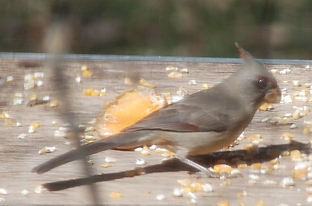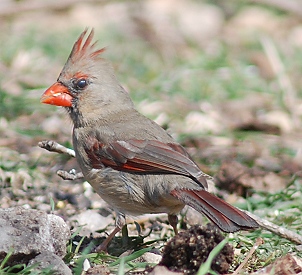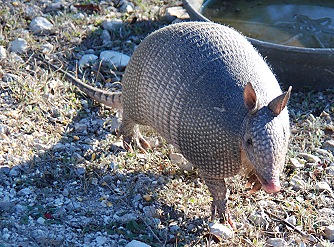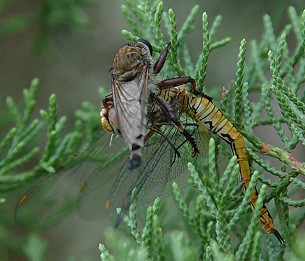Feb 05
Posted: under photography, Wildlife.
Tags: Activities, bird behavior, photography February 5th, 2009
In December 2002, I was birdwatching at the site of what would be Fox Pavilion (hadn’t been built yet.) We had a flock of cardinals that showed up every day…but that day, there was a female bird with them that wasn’t a cardinal. It was a Pyrrhuloxia, a close relative whose normal range is well […] [...more]
In December 2002, I was birdwatching at the site of what would be Fox Pavilion (hadn’t been built yet.) We had a flock of cardinals that showed up every day…but that day, there was a female bird with them that wasn’t a cardinal. It was a Pyrrhuloxia, a close relative whose normal range is well west of here.
I had only a little point and shoot camera then, and it was a heavily cloudy day, late in the afternoon, so my pictures of the female Pyrrhuloxia weren’t very good–just good enough to show that’s what it had to be. That female was somewhat melanistic, very dark indeed, noticeably darker than the female cardinals perched in the same scrubby trees.
I watched every winter, but did not see another one until today: on the feeder in the back yard. I wasn’t able to get a picture of it except through the study window–old glass, and can’t be opened so it can’t be cleaned–so it’s blurry–and handheld with my less-great lens, but here it is:

Pyrrhuloxia, female
Note that the bill is yellow, with the upper part (culmen) sharply curved, and the bird is a cool gray, with minimal red in the crest, around the eye, and in the folded wing.
Here’s a female cardinal (but this taken outside, so there’s no blurring by the old dirty glass in the window and with my best lens) as gray as they look in our yard–usually they show warmer colors–and always the red bill and more red in crest, eyes, wings, and tail.

Even though the Pyrrholoxia picture isn’t as good as I’d wish, it’s still nifty to see one back again, this time in sunlight and close enough to see details with the binoculars. I expect these “desert cardinals” (as we called them when I was a kid) to appear in our area more often as climate change makes it hotter and dryer.

Jan 18
Posted: under Activities, photography, Plantlife, Wildlife.
Tags: Activities, photography, wildlife management January 18th, 2009
Yesterday was the “nose to the grindstone” day for putting the annual report in final form, including choosing which pictures to include to show the story of the year on our place. The official form has nine pages. Add to that a cover sheet with our names and other useful information the form itself doesn’t […] [...more]
Yesterday was the “nose to the grindstone” day for putting the annual report in final form, including choosing which pictures to include to show the story of the year on our place.
The official form has nine pages. Add to that a cover sheet with our names and other useful information the form itself doesn’t have space for, and three pages of supplementary notes referencing specific points of the form (which, for instance, does not have a check-box for “check-dams/gabions” under “erosion control”–just ponds, dykes, and levees, so I have to add a note about our check-dams and gabions every year) , and then 14 pages that I call the Activity Report, detailing (well, outlining, but in more detail than their Annual Report Form makes possible) the activities we’ve done in each of the seven management areas with (where possible) photographs.
(Photos beyond the break)
Read the rest of this entry »

Jan 12
Posted: under Activities, Plantlife, Wildlife.
Tags: Activities, Animal behavior, beauty, observation, photography, supplemental feeding, wildlife management January 12th, 2009
Today’s wildlife experience was an armadillo, drinking noisily (they slurp, sounding rather like dogs) from the overflow guzzler at Fox Pavilion when we came back around that way after a long, two-hour stroll around the place. I thought I’d turned the water off completely, but some grit must’ve been in the faucet, because the water […] [...more]
Today’s wildlife experience was an armadillo, drinking noisily (they slurp, sounding rather like dogs) from the overflow guzzler at Fox Pavilion when we came back around that way after a long, two-hour stroll around the place. I thought I’d turned the water off completely, but some grit must’ve been in the faucet, because the water had overflowed.

Read the rest of this entry »

Jan 01
Posted: under Activities, Equipment, Land.
Tags: Activities, land management January 1st, 2009
The remnant pocket prairie in the creek woods that we call the “entrance meadow (it’s almost enclosed by woods and is the formal entrance to the thickest part of them) was for the first six years the best seed bank we had of original native plants. Little bluestem, Indiangrass, sideoats grama, Maximilian sunflower, pitcher sage, […] [...more]
The remnant pocket prairie in the creek woods that we call the “entrance meadow (it’s almost enclosed by woods and is the formal entrance to the thickest part of them) was for the first six years the best seed bank we had of original native plants. Little bluestem, Indiangrass, sideoats grama, Maximilian sunflower, pitcher sage, Illinois basketflower, brown-eyed Susan, gayfeather, and others are all found in this small area. Now that we have established other seed-source areas, we’re not as dependent on it, but we still want to maintain it as a pocket prairie, not let it be overgrown with greenbriar, cedar elm, roughleaf dogwood.
So, every winter, I mow it, on the highest setting the small mower can give (the large mower won’t even get into it.) Today was a good day for that, so today I got it done. I don’t try to break down all the tall stalks of the forbs (that takes repeated passes) but do try to knock them about and cut the grass at about 4.5 inches. “About” because it’s not absolutely level. In the scheme of things, this counts as “habitat management.”
On the way back, I mowed one of the work trails (useful for censusing grassland birds, among other things.)
Other work today (some done by R-) included checking all the wildlife waterers and putting out feed for migrant birds. That, of course, falls under “supplemental water” and “supplemental feeding.”

Dec 20
Posted: under Activities, photography, Wildlife.
Tags: Activities, Animal behavior, census, observation, photography December 20th, 2008
I’ve started working on a long-term project to define who eats what and is eaten by whom. Published sources are not as much help as you might think, since they’re not really local and the local mix of food sources varies from both historical record (we have different plants, in different proportions, and thus different […] [...more]

Robberfly taking a large dragonfly
I’ve started working on a long-term project to define who eats what and is eaten by whom. Published sources are not as much help as you might think, since they’re not really local and the local mix of food sources varies from both historical record (we have different plants, in different proportions, and thus different proportions of animals for the meat-eaters to prey on) and from published sources set in a different area.
It’s being every bit as difficult I suspected it would be. Critters do not all come and pose in front of the camera with an array of their food sources so consumption can be documented. Nor are they limited to the foods we put out. Killing a lot of native critters to do stomach content analyses (a very accurate way of finding out what *that* individual ate, but non-reproducible in that individual) isn’t something I want to do, or have the time and expertise to do anyway. Read the rest of this entry »





